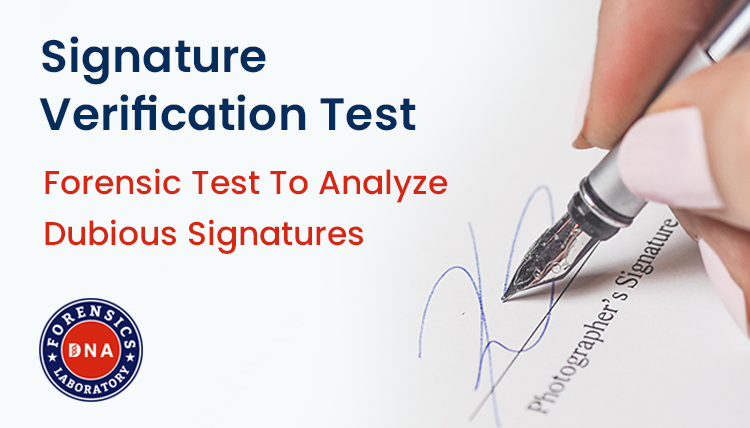Handwriting represents words, sentences, and languages. Both signatures & handwritings are biometrics that are unique to each individual. Signatures also play a vital role, being used for financial transactions, postal votes, consents, sanctions, and more. Moreover, they serve as a means of identification in business deals or to establish the legality of the documents. But, in today’s fast-paced and technologically advanced world, alleged fraud, forgery and cheating have evolved, making the signature verification forensics test, a critical method of fraud/forgery detection.
What is Signature Verification Process?
Signature verification is one of the biometric processes to analyze the slants, angles, spacing, the style of letters and numbers, pressure, and the formatting of words & paragraphs with the writing instruments used. Moreover, the experts can identify the document’s creator, the time frame, the materials used, and the modifications made.
Types of Documents Processed for Signature Verification Tests
Signs are formations rather than alphabets that can be done freely, smoothly, or hesitantly with different pressures and curves. Forensic tests for signature verification can identify these formations & curves and can declare them as genuine or fraudulent.

Signature Verification Forensics Test Can help into the Following Cases:
- Extortion notes
- Suicide notes under question
- Loan and mortgage documents
- Property/Inheritance documents
- Will documents
- Authenticity of Legal Documents
- Counterfeiting
- Forged business contracts, etc
Various equipment, methods, and tools are employed to determine authenticity and authorship during signature verification process. However, it is noteworthy that forensic document examination is not the same as “graphology,” which claims to decipher the personality traits of the composer from their handwriting.
Document Forgery & Its Types
Forgery, also called white-collar crime, refers to the fabrication or alteration of a document with the intent to defraud someone. It comes under section 465 IPC (Indian Penal Code) shall be punished with imprisonment or with fine, or both.
Document forgery occurs in many different ways, and there are various ways to spot it in documents and signatures. Forgeries can be found in signatures, handwriting, and even as digital manipulation.
Attempts to Forge Signatures Occur in 4 Ways:
- Simple Forgery – As the name implies, this is a very simple form of forgery done with minimal effort. A writer will write something or sign a document without applying any effort to follow a known sample of the handwriting and signature.
- Free Hand Simulation – It is a little more detailed than simple forgery. An individual who attempts freehand simulation has a sample of the handwriting or signature to study. The forger will then attempt to recreate the shapes and styles of handwriting and signatures. The characteristics of simulation are hesitation, slow speed, unusual pen lift, more ink deposition, and execution of letters.
- Tracing – The person will attempt to reproduce the signature’s most obvious or prominent features or handwritten text with tracing method. This is typically created by transmitted light, carbon intermediate, and pressure intended. Tracing characteristics are that strokes get blunt in nature, ink deposition, pen lifts, and pause.
- Electronic Manipulation – Electronic manipulation opens a wide range of possibilities for document forgery. For example, photo editing software is used to copy and alter the text in digital documents and digitally scanned documents.
Thereupon, a forensic examiner would have to consider the above possibilities and more for signature verification to get a conclusive report. If some cases are of legal concern, it is important to choose the right signature verification test experts or forensic laboratory for a positive result.
Signs of Forgery
There are some key indicators of the forged documentaries in the signature verification forensics test:
- Blunt Starts & Stops – If a signature ended naturally, it would have trailed off with the momentum of the pen. However, a forged copy might have stopped abruptly or left an inkblot indicating a blunt pause.
- Pen lifts & Hesitations – Forgers uncertain about their craft may not have the smooth motion and immediate precision required. Pen lifts and hesitations are visible in strange gaps in the words or overlapping ink.
- Tremors – A lack of confidence leads to visible bumps and shakes in the ink trail from the pen’s unsteady movement. These may not be visible to the naked eye.
- Speed & Pressure – A forged copy might have a thick, uniform line of ink suggests the hand used a prolonged and precise technique to create the shapes.
- Patching – The final trait that examiners will look out for in handwriting examination forensics test is patching. This means to check any kind of attempts done to correct the signature to make it look right.
Why DNA Forensics Laboratory for Signature Verification Test in India?
DNA Forensics Laboratory Pvt. Ltd. (DFL) is one of the best and most trusted Indian companies to provide 100% accurate, conclusive, and accredited signature verification tests at competitive prices. We use specialized examination techniques to examine the documents, such as detecting alterations, additions, erasures, and obliterations with experts. Indian courts and many law-enforcement agencies trust us for our credibility. Therein, signature verification forensic tests at DFL can save you from many troubles.
To learn more or book signature verification forensics tests in India, talk to our customer support executives on the given numbers: +91 8010177771 (Call) or +91 9266615552 (WhatsApp)






